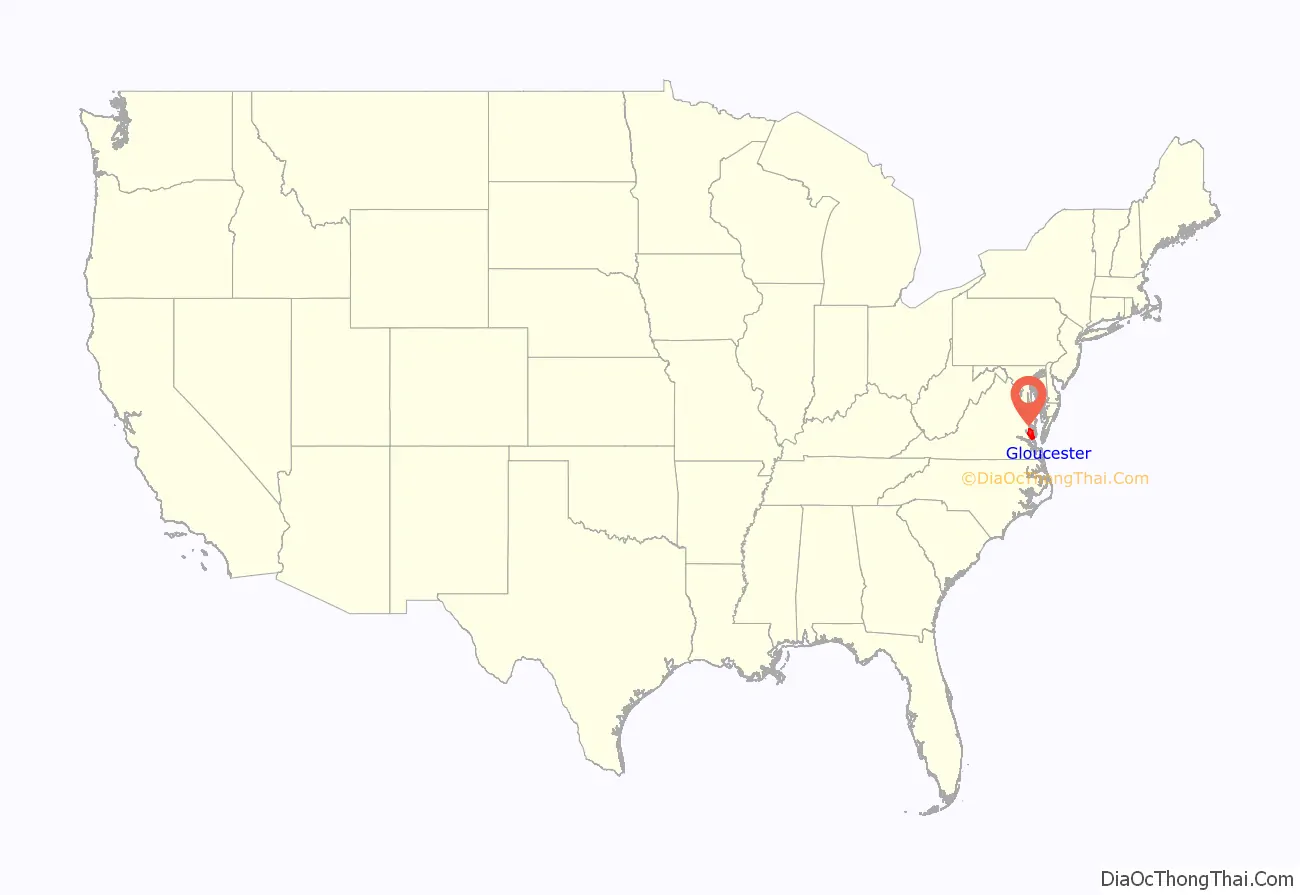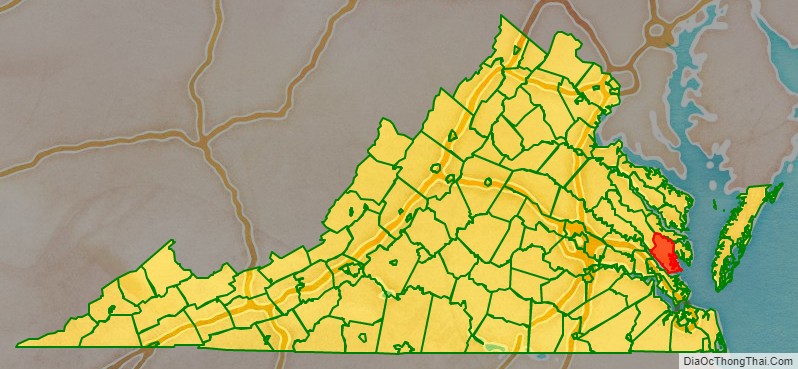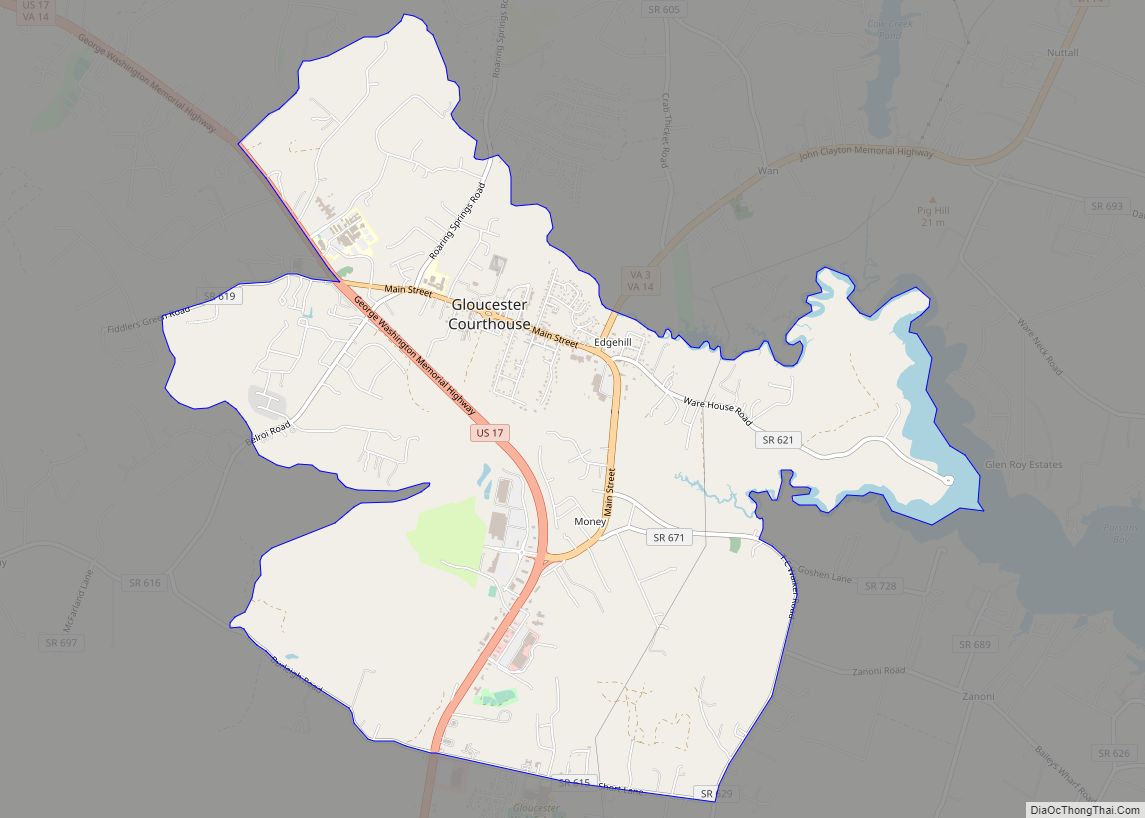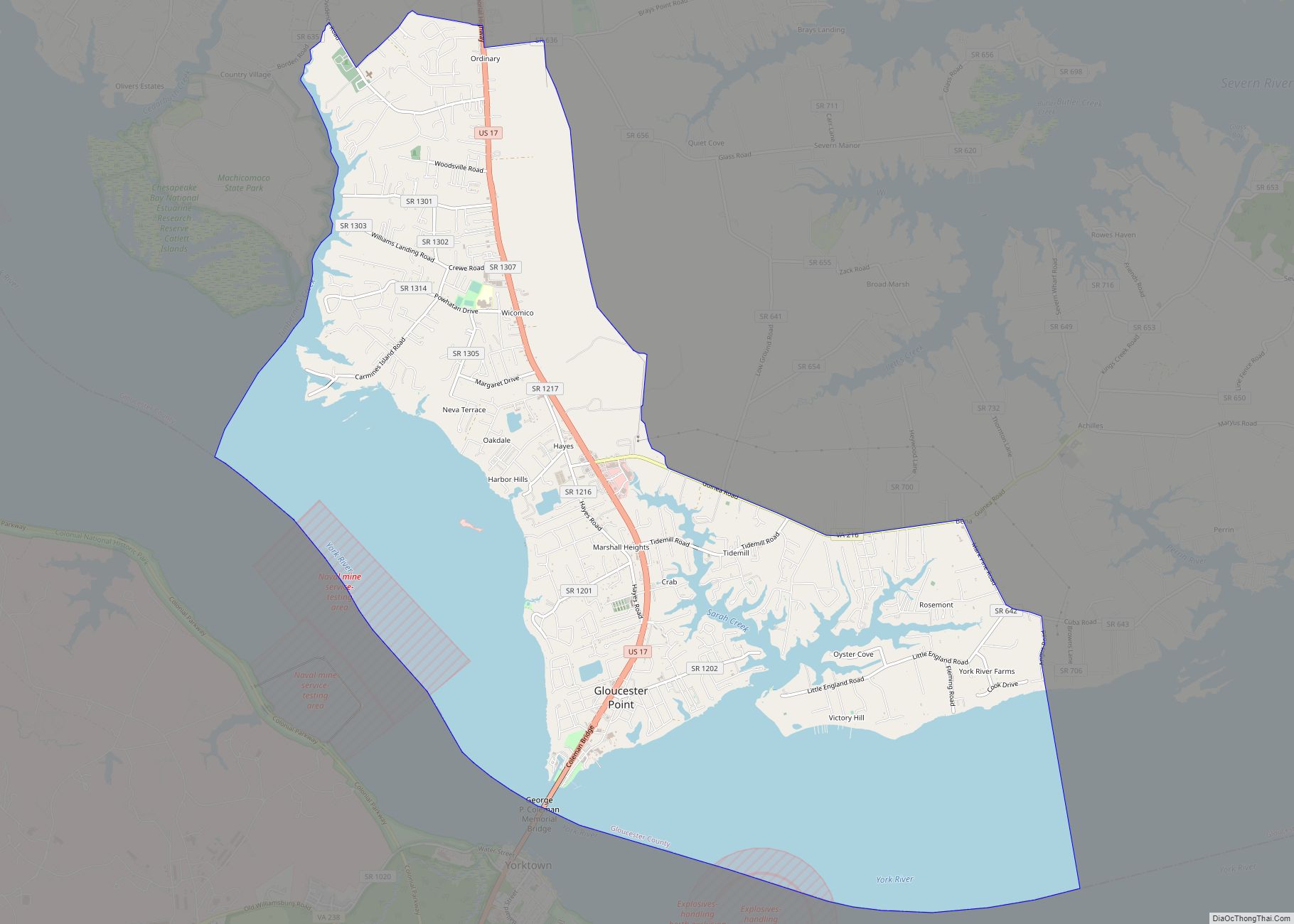Gloucester County (/ˈɡlɒstər/) is a county in the Commonwealth of Virginia. As of the 2020 census, the population was 38,711. Its county seat is Gloucester Courthouse. The county was founded in 1651 in the Virginia Colony and is named for Henry Stuart, Duke of Gloucester (third son of King Charles I of England).
Gloucester County is included in the Virginia Beach–Norfolk–Newport News, VA–NC Metropolitan Statistical Area. Located at the east end of the lower part of the Middle Peninsula, it is bordered on the south by the York River and the lower Chesapeake Bay on the east. The waterways shaped its development. Gloucester County is about 60 miles (97 km) east of Virginia’s capital, Richmond.
Werowocomoco, capital of the large and powerful Powhatan Confederacy (a union of 30 indigenous tribes under a paramount chief), was located on this part of the peninsula. In 2003 archeologists established that dense village had been located at this site from AD 1200 to the early 17th century.
The county was developed by colonists primarily for tobacco plantations, based on the labor of enslaved Africans imported in the slave trade. Tobacco was one of the first commodity crops but fishing also developed as an important industry. The county was home to numerous planters who were among the First Families of Virginia and leaders before the American Revolutionary War. Thomas Jefferson wrote early works for Virginia and colonial independence while staying at Rosewell Plantation, home of John Page (his close friend and fellow student at the College of William and Mary).
Gloucester County is rich in farmland. Its fishing industry is important to the state as well. It has a retail center located around the main street area of the county seat. Gloucester County and adjacent York County are linked by the George P. Coleman Memorial Bridge, a toll facility across the York River carrying U.S. Route 17 to the Virginia Peninsula area. Gloucester County is self-nicknamed the “Daffodil Capital of the World”; it hosts an annual daffodil festival, parade and flower show.
| Name: | Gloucester County |
|---|---|
| FIPS code: | 51-073 |
| State: | Virginia |
| Founded: | 1651 |
| Named for: | Henry Stuart, Duke of Gloucester |
| Seat: | Gloucester Courthouse |
| Total Area: | 288 sq mi (750 km²) |
| Land Area: | 218 sq mi (560 km²) |
| Total Population: | 38,711 |
| Population Density: | 130/sq mi (52/km²) |
Gloucester County location map. Where is Gloucester County?
History
Prehistoric
This area was inhabited for thousands of years by successive cultures of hunter-gatherer Indian peoples; artifacts have been dated to at least the late Woodland Period (c. AD 1000).
An important village site known as Werowocomoco was occupied by c. AD 1200 by the Algonquian-speaking peoples of the numerous emerging tribes in the area. Before the late 16th century, the Powhatan Confederacy had been formed. It was made up of an estimated 30 tribes in the coastal region, who spoke distinct but related languages, and was led by a paramount chief, known as the Powhatan. The Powhatan Confederacy was estimated to total 12,000 to 15,000 people across the coastal region of present-day Virginia. Werowocomoco was the stronghold and capital of this confederacy, located on the north side of the York River in what is now Gloucester.
This complex, stratified society had developed in part due to the cultivation and processing by women of varieties of maize, beans and squash. With these crops, the women produced a surplus that, together with the game and fish collected by the men, supported a dense population in a number of settlements. The people also gathered nuts, berries and other foods of the region.
European colonists
Around 1570, Spanish Jesuits attempted to establish what was known as the Ajacan Mission on the south shore of the York River across from Gloucester. They were killed by natives led by a Christian convert named Don Luis, who was affiliated with a village known as Chiskiack (Naval Weapons Station Yorktown much later was developed at this site in present-day York County; the historic village site has been preserved.)
When English settlers founded Jamestown in 1607 on the James River to the north, they soon came into conflict with local Indians. The newcomers competed for land, game and other resources in the Powhatan territory, and the two cultures did not understand each other’s concepts of property, particularly in land use.
In late 1607, John Smith was captured and taken to Chief Powhatan at Werowocomoco, his eastern capital. According to legend, Powhatan’s daughter Pocahontas saved John Smith from being executed by the natives; however, some historians question the accuracy of much of Smith’s account of that incident. Smith was accompanied by other Englishmen when he returned in a later visit to the Powhatan at Werowocomoco.
Lost site of Werowocomoco
After the Powhatan moved their capital to a safer, inland location and abandoned the village around 1609, knowledge of this site was lost. Researchers later tried to identify it by Smith’s historic writings. The current site of West Point seemed to offer a clue to its location; from there, Smith had noted the distance downstream to Werowocomoco. Based upon his description, at one time scholars thought the former capital was located near Wicomico (site of Powhatan’s Chimney), about 25 miles (40 km) southeast of present-day West Point. Smith also noted that Jamestown was 12 miles (19 km) from Werowocomoco “as the crow flies.” Using that measure, the site near Wicomico is about 12 miles from Jamestown.
In 1977, archeologist Daniel Mouer of Virginia Commonwealth University identified a site on Purtan Bay as the possible location of Werowocomoco; it was also about 12 miles from Jamestown. He was able to collect artifacts from the surface of plowed fields and along the beach, but the landowner did not want any excavation. Mouer found fragments of Indian ceramics dating to the Late Woodland Period, and determined that the area was the possible site of Werowocomoco.
More than 20 years later, a different landowner authorized archaeological excavation on the property. Between March 2002 and April 2003, the Werowocomoco Research Group conducted excavations and analysis at the Werowocomoco site. The research group is a collaborative effort of the College of William and Mary, the Virginia Department of Historic Resources, and Virginia tribes descended from the Powhatan Confederacy. Initial testing included digging 603 test holes 12 to 16 inches (30 to 41 cm) deep and 50 feet (15 m) apart. They found thousands of artifacts, including a blue bead which may have been made in Europe for trading. Combined with the historical descriptions by English colonists of Werowocomoco, researchers believe these discoveries have established the site of the ancient capital. “We believe we have sufficient evidence to confirm that the property is indeed the village of Werowocomoco,” said Randolph Turner, director of the Virginia Department of Historic Resources’ Portsmouth Regional Office in 2003.
Two Gloucester-based archaeologists, Thane Harpole and David Brown, have worked at the site since 2002 and continue to participate in the excavations. Archeologists have discovered a dispersed village community occupying the site from AD 1200 through the early 17th century. They recovered artifacts (including native pottery and stone tools), as well as floral and faunal food remains from the large residential community. The research group has also recovered English trade goods produced from glass, copper, and other metals originating in Jamestown. The colonists’ accounts of interaction at Werowocomoco during the early days of Jamestown emphasized Powhatan’s interests in acquiring English objects (particularly copper, which the Indians used to create their own objets d’art.
The project is noted for the researchers’ consultation and collaboration with members of the local Indian tribes – the Mattaponi and Pamunkey, descendants of the Powhatan Confederacy. Such archeological sites often contain burials and associated sacred artifacts important to these tribes.
Gloucester County has celebrated Werowocomoco and other Powhatan-heritage sites as part of the county’s history. Both the newly identified site on Purtan Bay and Powhatan’s Chimney at Wicomico are within the territory which Indians have considered as part of Werowocomoco. In the Algonquian language, the “village” of the chief was not defined as a small place, but the term referred to “the lands” where he lived. The custom of the Powhatan tribes was to relocate their villages within a general area to allow lands to recover from cultivation, or move to better sources of water and game.
English developments
In 1619, the Virginia Company divided its developed areas into four incorporations, called “citties” [sic]. At that time, most of the area which became Gloucester County would have been considered part of “James Cittie” (although it was not yet settled). In 1634, by order of King Charles I the colony was divided into the eight shires of Virginia. First named Charles River Shire by the English, York County was renamed in 1642 during the English Civil War. The Pamunkey called the river of their territory “Pamunkey”; residents retained that name for the portion upstream from West Point. The English first named the major river the Charles River; during the English Civil War, it was renamed as the York River).
The colonial government granted early land patents in the area in 1639, but it was not until after 1644 that Gloucester was considered safe for settlement. By that time, Algonquian peoples had been pushed out of the area by colonists after many died in epidemics of infectious diseases. They had no immunity to the new diseases carried by the Europeans. George Washington’s great-grandfather received a Gloucester County land patent in 1650.
Gloucester County formation and divisions
Gloucester County was formed from York County in 1651. No legislative enactment has been found for its formation. Gloucester County consisted of four parishes: Abingdon, Kingston, Petsworth and Ware. It was named for Henry Stuart, Duke of Gloucester, third son of Charles I. Gloucester County figured prominently in the history of the colony and the Commonwealth of Virginia. Kingston parish was renamed as Mathews County in 1791, after the American Revolutionary War and independence of the United States. The remaining three parishes were retained in Gloucester; the county was split on what is now the eastern county line.
Plantations and historic sites
During the 17th and 18th centuries, Gloucester was developed as a major tobacco-producing area; this was the chief commodity crop and the basis of the wealth of major planters. Many of the old plantation houses and private estates have been preserved in good condition. These establishments are periodically open to public visitation during Historic Garden Week. Examples of colonial architecture are the Episcopal churches of Ware (1690) and Abingdon (1755), where Presidents Washington and Jefferson worshiped. Some early colonial buildings at the county seat on Courthouse Green continue to be used for public purposes.
During the 17th century, the tip of land protruding into the York River was named Tyndall’s Point by Robert Tyndall, mapmaker for Captain John Smith. In 1667, colonists built fortifications there, at what was then called Gloucester Point. These defenses were rebuilt and strengthened many times from the colonial period through the American Civil War. This site is also known for the “Second Surrender” by General Lord Charles Cornwallis to General George Washington at Yorktown.
Guinea
One area of Gloucester County is known as Guinea; it includes the unincorporated communities of Achilles, Bena, Severn and Big Island. Located near Gloucester Point, the area has been the center of the county’s seafood industry. (The Shackelford, Rowe, West, Jenkins, Green, Kellum, King and Belvin families are chief among those who have worked in the fishing industry here). Although the industry has declined, it remains a cultural core of the community. The fishermen are known locally as “Guineamen”. They speak a distinct form of non-rhotic, Southern English.
The name “Guinea” is of uncertain origin. Residents in this area have been referred to as “Guineamen” at least since 1730. As noted by George Dow in 1969, London physician George Pinckard referred to the master of a ship containing slaves from the Guinea coast as a “Guinea Man” in letters dating 1795. It is likely this area was called Guinea after being used as a landing site for importation of slaves from that area. Another story, passed among the “Guineamen” is that people on the Guinea Neck were continuing to use golden Guineas to pay for things up from about 1781–1860, the start of the American Civil War.
At one time, the name was thought to have derived from the period of the American Revolutionary War. Loyalists quartered Hessian mercenaries here who were attached to Cornwallis’ army; they were paid one guinea per day. The Hessians were thought to have occupied lower Gloucester during the closing days of the Revolutionary War, or to have settled here after deserting the British. Cornwallis sent British troops and cavalry to occupy Gloucester in October 1781; Hessians may have been a part of that contingent due to Gloucester’s strategic importance at the mouth of the York River.
Daffodils
The history of the daffodil in Gloucester County is nearly as old as the county. When Gloucester was formed in 1651 from part of York County, early settlers brought daffodils from England. Settlers soon discovered the soil and weather conditions were good for them. The bulbs were passed from neighbor to neighbor, naturalizing by the beginning of the 20th century. The daffodil industry (which earned the county the title “Daffodil Capital of America”) developed during the 1930s and 1940s. Today, the county’s daffodils are celebrated every year with the annual “Daffodil Festival”. The whole county comes out during the first weekend in April to celebrate the county’s history. .
Modern day
Gloucester is a growing and increasingly changing county that is an integral part of the Hampton Roads metropolitan area. Growth in the Peninsula area has encouraged development in the Gloucester Point and the Courthouse regions of Gloucester. Gloucester’s Main Street and U.S. Route 17 have served as vital corridors of commercial and community growth in the county. Between 1970 and 2000, the county’s population grew by over 60% and this additional influx of new residents encouraged mass commercial and residential development, and subsequently has become an important commercial center for the Middle Peninsula, upper Hampton Roads, and the Northern Neck areas.
Canon Virginia has a recycling facility in the White Marsh area of the county, which processes old printer cartridges and recycle their parts for new cartridges. Peace Frogs, based near Gloucester Courthouse is an apparel brand that makes a full line of apparel and accessories sporting frog designs.
The Virginia Institute of Marine Science is based in Gloucester Point. VIMS is the College of William & Mary’s Marine Science post-graduate school.
Despite an influx in development, Gloucester still maintains a large amount of rural and farmland (especially in the northern end of the county) which contributes to the county’s rich agricultural tradition.
Gloucester County’s Comprehensive Plan cites both Gloucester Point and Gloucester Courthouse as development districts.
Gloucester County Road Map
Geography
According to the U.S. Census Bureau, the county has a total area of 288 square miles (750 km), of which 218 square miles (560 km) is land and 70 square miles (180 km) (24.4%) is water.
Adjacent counties
- Middlesex County – north
- Mathews County – east
- York County – south
- James City County – southwest
- King and Queen County – west
Major highways
- US 17 (George Washington Memorial Highway)
- SR 3 (Burkes Point Road)
- SR 14 (John Clayton Memorial Highway)
- SR 33 (Lewis B. Puller Memorial Highway)
- SR 198 (Glenns/Dutton Roads)
- SR 216 (Guinea Road)
- SR 374 (College Drive)















